Yamaha TTR230 V 2006 Owner's manual
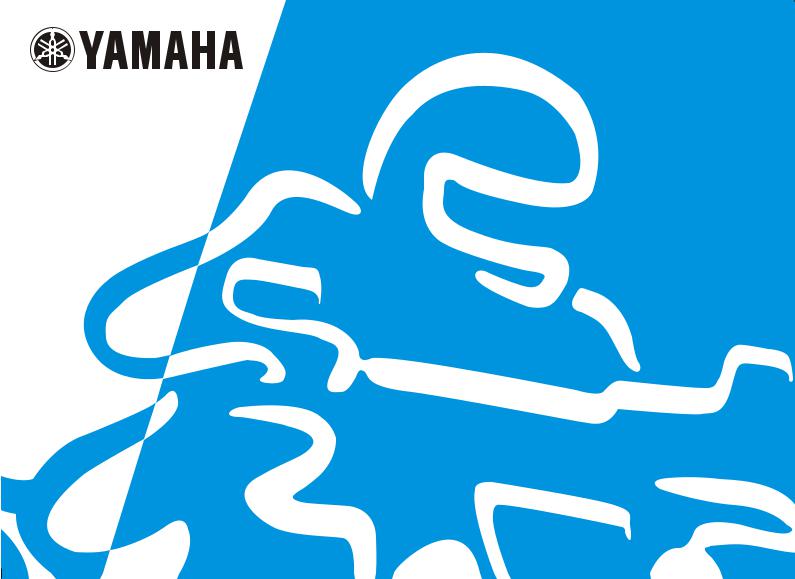
OWNER’S MANUAL
TT-R230V
1C6-F8199-21

INTRODUCTION
Congratulations on your purchase of the Yamaha TTR230V. This model is the result of Yamaha’s vast experience in the production of fine sporting, touring, and pacesetting racing machines. It represents the high degree of craftsmanship and reliability that have made Yamaha a leader in these fields.
This manual will give you an understanding of the operation, inspection, and basic maintenance of this motorcycle. If you have any questions concerning the operation or maintenance of your motorcycle, please consult a Yamaha dealer.
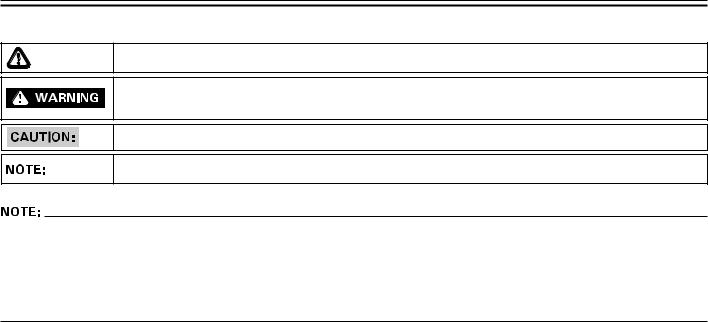
IMPORTANT MANUAL INFORMATION
Particularly important information is distinguished in this manual by the following notations:
The Safety Alert Symbol means ATTENTION! BECOME ALERT! YOUR SAFETY IS INVOLVED!
Failure to follow WARNING instructions could result in severe injury or death to the motorcycle operator, a bystander or a person inspecting or repairing the motorcycle.
A CAUTION indicates special precautions that must be taken to avoid damage to the motorcycle.
A NOTE provides key information to make procedures easier or clearer.
●This manual should be considered a permanent part of this motorcycle and should remain with it even if the motorcycle is subsequently sold.
●Yamaha continually seeks advancements in product design and quality.Therefore, while this manual contains the most current product information available at the time of printing, there may be minor discrepancies between your motorcycle and this manual. If you have any questions concerning this manual, please consult your Yamaha dealer.
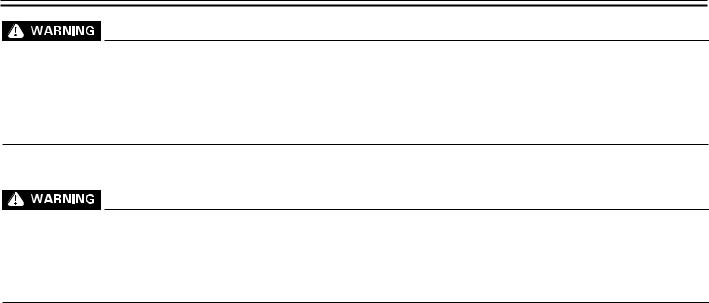
IMPORTANT MANUAL INFORMATION
PLEASE READ THIS MANUAL AND THE “YOU AND YOUR MOTORCYCLE: RIDING TIPS” BOOKLET CAREFULLY AND COMPLETELY BEFORE OPERATING THIS MACHINE. DO NOT ATTEMPT TO OPERATE THIS MOTORCYCLE UNTIL YOU HAVE ATTAINED ADEQUATE KNOWLEDGE OF ITS CONTROLS AND OPERATING FEATURES AND UNTIL YOU HAVE BEEN TRAINED IN SAFE AND PROPER RIDING TECHNIQUES. REGULAR INSPECTIONS AND CAREFUL MAINTENANCE, ALONG WITH GOOD RIDING SKILLS, WILL ENSURE THAT YOU SAFELY ENJOY THE CAPABILITIES AND THE RELIABILITY OF THIS MOTORCYCLE.
THIS MACHINE IS DESIGNED AND MANUFACTURED FOR OFF-ROAD USE ONLY. IT IS ILLEGAL TO OPERATE THIS MACHINE ON ANY PUBLIC STREET, ROAD OR HIGHWAY. SUCH USE IS PROHIBITED BY LAW.THIS MACHINE COMPLIES WITH ALMOST ALL STATE OFF-HIGHWAY NOISE LEVEL AND SPARK ARRESTER LAWS AND REGULATIONS. PLEASE CHECK YOUR LOCAL RIDING LAWS AND REGULATIONS BEFORE OPERATING THIS MACHINE.
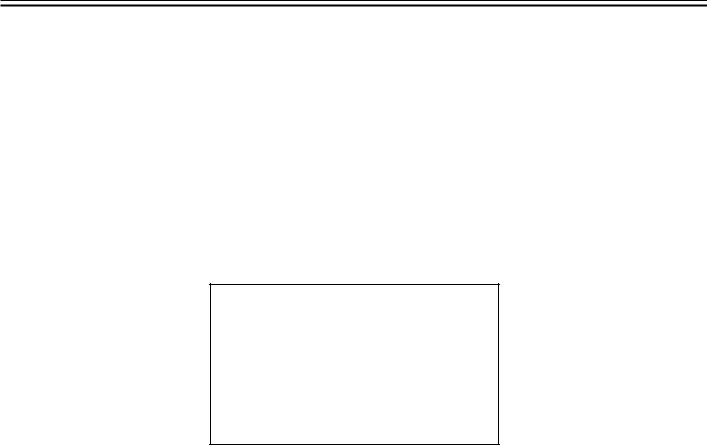
IMPORTANT MANUAL INFORMATION
TTR230V
OWNER’S MANUAL
c 2005 byYamaha Motor da Amazônia Ltda. 1st edition, May 2005
All rights reserved.
Any reprinting or unauthorized use without the written permission of Yamaha Motor da Amazônia Ltda. is expressly prohibited.
Printed in Brazil.

TABLE OF CONTENTS
SAFETY INFORMATION .................... |
1-1 |
Location of important labels ............ |
1-6 |
DESCRIPTION ................................... |
2-1 |
Left view .......................................... |
2-1 |
Right view ........................................ |
2-2 |
Controls and instruments ................ |
2-3 |
INSTRUMENT AND CONTROL |
|
FUNCTION ......................................... |
3-1 |
Main switch ..................................... |
3-1 |
Handlebar switches ........................ |
3-1 |
Clutch lever ..................................... |
3-2 |
Shift pedal ....................................... |
3-2 |
Brake lever ...................................... |
3-2 |
Brake pedal ..................................... |
3-3 |
Fuel tank cap ................................... |
3-3 |
Fuel ................................................. |
3-3 |
Fuel tank breather hose .................. |
3-5 |
Fuel cock ......................................... |
3-5 |
Starter (choke) knob ........................ |
3-6 |
Seat ................................................. |
3-6 |
Adjusting the shock absorber |
|
assembly ...................................... |
3-7 |
Starting circuit cut-off system .......... |
3-8 |
PRE-OPERATION CHECKS .............. |
4-1 |
Pre-operation check list .................. |
4-1 |
OPERATION AND IMPORTANT RIDING
POINTS ............................................... |
|
|
5-1 |
Starting and warming up a cold |
|
||
engine .......................................... |
|
|
5-1 |
Starting a warm engine ................... |
5-2 |
||
Shifting ............................................ |
|
|
5-2 |
Engine break-in ............................... |
|
5-3 |
|
Parking ............................................ |
|
|
5-4 |
PERIODIC MAINTENANCE AND |
|
||
MINOR REPAIR .................................. |
|
|
6-1 |
Periodic maintenance chart for the |
|||
emission control system .............. |
6-2 |
||
General maintenance and lubrication |
|||
chart ............................................. |
|
|
6-3 |
Removing and installing the panels 6-6 |
|||
Checking the spark plug ................. |
6-7 |
||
Engine oil and oil filter element ...... |
6-8 |
||
Cleaning the air filter element ....... |
6-11 |
||
Adjusting the carburetor ................ |
6-13 |
||
Adjusting the throttle cable |
|
||
free play ..................................... |
|
|
6-13 |
Adjusting the valve clearance ....... |
6-13 |
||
Tires ............................................... |
|
|
6-14 |
Spoke wheels ................................ |
|
|
6-16 |
Adjusting |
the |
clutch |
lever |
free play ..................................... |
|
|
6-16 |
Adjusting the brake pedal position 6-17 |
|||
Checking the front brake |
|
||
pads and rear brake shoes ....... |
6-18 |
||
Checking the brake fluid level ...... |
6-18 |
||
Changing the brake fluid .............. |
6-19 |
Drive chain slack ........................... |
6-19 |
Lubricating the drive chain ........... |
6-20 |
Checking and lubricating |
|
the cables .................................. |
6-21 |
Checking and lubricating |
|
the throttle grip and cable .......... |
6-21 |
Checking and lubricating |
|
the brake and clutch levers ....... |
6-22 |
Lubricating the brake pedal .......... |
6-22 |
Checking and lubricating |
|
the sidestand ............................. |
6-22 |
Checking the front fork .................. |
6-23 |
Checking the steering ................... |
6-23 |
Checking the wheel bearings ....... |
6-24 |
Battery ........................................... |
6-24 |
Replacing the fuse ........................ |
6-26 |
Supporting the motorcycle ............ |
6-26 |
Front wheel .................................... |
6-27 |
Rear wheel .................................... |
6-27 |
Troubleshooting ............................ |
6-29 |
Troubleshooting chart ................... |
6-30 |
MOTORCYCLE CARE AND |
|
STORAGE ........................................... |
7-1 |
Care ................................................. |
7-1 |
Storage ............................................ |
7-3 |
SPECIFICATIONS .............................. |
8-1 |

TABLE OF CONTENTS
CONSUMER INFORMATION ............. |
9-1 |
Identification numbers ..................... |
9-1 |
Maintenance record ........................ |
9-2 |

|
|
|
|
|
|
|
SAFETY INFORMATION |
||||
|
|
|
|
|
|
|
|
||||
MACHINES ARE SINGLE TRACK |
Safe riding |
|
|
angle for the speed). Never travel |
|||||||
VEHICLES. THEIR SAFE USE AND |
● Always make pre-operation checks. |
faster than warranted by conditions. |
|||||||||
OPERATION ARE DEPENDENT UPON |
Careful checks may help prevent |
● Ride cautiously in unfamiliar areas. |
|
||||||||
1 |
|||||||||||
THE USE OF PROPER RIDING |
an accident. |
|
|
You may encounter hidden |
|||||||
TECHNIQUES AS WELL AS THE |
● This machine is designed for off- |
obstacles that could cause an |
|
||||||||
|
|||||||||||
EXPERTISE OF THE OPERATOR. |
road use only, therefore, it is illegal |
accident. |
|||||||||
EVERY OPERATOR SHOULD KNOW |
to operate it on public streets, |
● The posture of the operator is |
|||||||||
THE FOLLOWING REQUIREMENTS |
roads, or highways. Off-road use on |
important for proper control. The |
|||||||||
BEFORE RIDING THIS MACHINE. |
|
public lands may be illegal. Please |
operator should keep both hands on |
||||||||
HE OR SHE SHOULD: |
|
|
check local regulations before |
the handlebar and both feet on the |
|||||||
● OBTAIN |
THOROUGH |
riding. |
|
|
operator footrests during operation |
||||||
INSTRUCTIONS |
FROM |
A |
● This machine is designed to carry |
to maintain control of the machine. |
|||||||
COMPETENT SOURCE ON ALL |
the operator only. No passengers. |
● Never ride under the influence of |
|||||||||
ASPECTS |
OF |
MACHINE |
● Many accidents |
involve |
alcohol or other drugs. |
||||||
OPERATION. |
|
|
|
inexperienced operators. |
Protective apparel |
||||||
● OBSERVE THE WARNINGS AND |
• Make sure that you are qualified |
The majority of fatalities from machine |
|||||||||
M A I N T E N A N C E |
and that you only lend your |
accidents are the result of head injuri- |
|||||||||
REQUIREMENTS |
IN THE |
machine to |
other |
qualified |
es. The use of a safety helmet is the |
||||||
OWNER’S MANUAL. |
|
|
operators. |
|
|
single most critical factor in the |
|||||
● OBTAIN QUALIFIED TRAINING IN |
• Know your skills and limits. |
prevention or reduction of head injuries. |
|||||||||
SAFE AND PROPER RIDING |
Staying within your limits may |
● Always wear an approved helmet. |
|||||||||
TECHNIQUES. |
|
|
help you to avoid an accident. |
● Wear a face shield or goggles.Wind |
|||||||
● OBTAIN |
PROFESSIONAL |
● Many accidents have been caused |
in your unprotected eyes could |
||||||||
TECHNICAL |
SERVICE |
AS |
by error of the machine operator. A |
contribute to an impairment of |
|||||||
INDICATED BY THE OWNER’S |
typical error made by the operator |
vision that could delay seeing a |
|||||||||
MANUAL AND/OR WHEN MADE |
is veering wide on a turn due to |
hazard. |
|||||||||
NECESSARY BY MECHANICAL |
EXCESSIVE |
SPEED or |
● The use of a jacket, heavy boots, |
||||||||
CONDITIONS. |
|
|
undercornering (insufficient lean |
trousers, gloves, etc., is effective |
|||||||
1 - 1

SAFETY INFORMATION
in preventing or reducing abrasions or lacerations.
●Never wear loose-fitting clothes,
1otherwise they could catch on the control levers, footrests, or wheels and cause injury or an accident.
●Never touch the engine or exhaust system during or after operation. They become very hot and can cause burns. Always wear protective clothing that covers your legs, ankles, and feet.
Modifications
Modifications made to this machine not approved by Yamaha, or the removal of original equipment, may render the machine unsafe for use and may cause severe personal injury. Modifications may also make your machine illegal to use.
Loading and accessories
Adding accessories or cargo to your machine can adversely affect stability and handling if the weight distribution of the machine is changed. To avoid the possibility of an accident, use extreme caution when adding cargo or accessories to your machine. Use extra care when riding a machine that has added cargo or accessories. Here are some general guidelines to follow if loading cargo or adding accessories to your machine:
Loading
The total weight of the operator, accessories and cargo must not exceed the maximum load limit of 90 kg (198 lb). When loading within this weight limit, keep the following in mind:
●Cargo and accessory weight should be kept as low and close to the machine as possible. Make sure to distribute the weight as evenly as possible on both sides of the machine to minimize imbalance or instability.
●Shifting weights can create a sudden imbalance. Make sure that accessories and cargo are securely
1 - 2
attached to the machine before riding. Check accessory mounts and cargo restraints frequently.
●Never attach any large or heavy items to the handlebar, front fork, or front fender. These items, including such cargo as sleeping bags, duffel bags, or tents, can create unstable handling or a slow steering response.
Accessories
Genuine Yamaha accessories have been specifically designed for use on this machine. SinceYamaha cannot test all other accessories that may be available, you must personally be responsible for the proper selection, installation and use of non-Yamaha accessories. Use extreme caution when selecting and installing any accessories. Keep these guidelines in mind for mounting accessories in addition to those provided under “Loading”.
●Never install accessories or carry cargo that would impair the performance of your machine. Carefully inspect the accessory before using it to make sure that it

SAFETY INFORMATION
does not in any way reduce ground clearance or cornering clearance, limit suspension travel, steering travel or control operation, or obscure lights or reflectors.
•Accessories fitted to the handlebar or the front fork area can create instability due to improper weight distribution or aerodynamic changes. If accessories are added to the handlebar or front fork area, they must be as lightweight as possible and should be kept to a minimum.
•Bulky or large accessories may seriously affect the stability of the machine due to aerodynamic effects. Wind may attempt to lift the machine, or the machine may become unstable in cross winds.
•Certain accessories can displace the operator from his or her normal riding position.This improper position limits the freedom of movement of the operator and may limit control ability,
therefore, such accessories are not recommended.
●Use caution when adding electrical accessories. If electrical accessories exceed the capacity of the machine’s electrical system an electric failure could result, which could cause a dangerous loss of lights or engine power.
Gasoline and exhaust gas
●GASOLINE IS HIGHLY FLAMMABLE:
•Always turn the engine off when refueling.
•Take care not to spill any gasoline on the engine or exhaust pipe(s)/ muffler(s) when refueling.
•Never refuel while smoking or in the vicinity of an open flame.
●Never start the engine or let it run for any length of time in a closed area. The exhaust fumes are poisonous and may cause loss of consciousness and death within a short time. Always operate your machine in an area that has adequate ventilation.
●Always turn the engine off before
1 - 3
leaving the machine unattended |
|
and remove the key from the main |
|
switch.When parking the machine, |
1 |
note the following: |
•The engine and exhaust pipe(s)/ muffler(s) may be hot, therefore, park the machine in a place where pedestrians or children are not likely to touch these hot areas.
•Do not park the machine on a slope or soft ground, otherwise it may fall over.
•Do not park the machine near a flammable source (e.g., a kerosene heater, or near an open flame), otherwise it could catch fire.
●When transporting the machine in another vehicle, make sure that it is kept upright and that the fuel cock(s) are turned to “ON” or “RES” (for vacuum type)/”OFF” (for manual type). If the machine should lean over, gasoline may leak out of the carburetor or fuel tank.
●If you should swallow any gasoline, inhale a lot of gasoline vapor, or allow gasoline to get into your eyes,

SAFETY INFORMATION
see your doctor immediately. If any gasoline spills on your skin or clothing, immediately wash the
1affected area with soap and water and change your clothes.
1 - 4

SAFETY INFORMATION
1
1 - 5
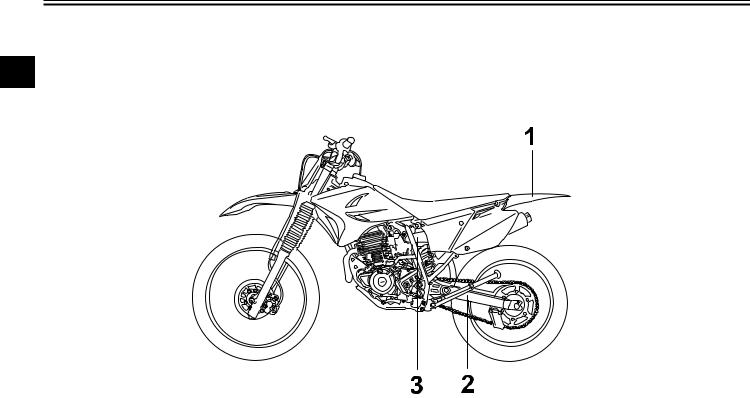
SAFETY INFORMATION
Location of important labels
Please read the following important labels carefully before operating this vehicle.
1
1 - 6
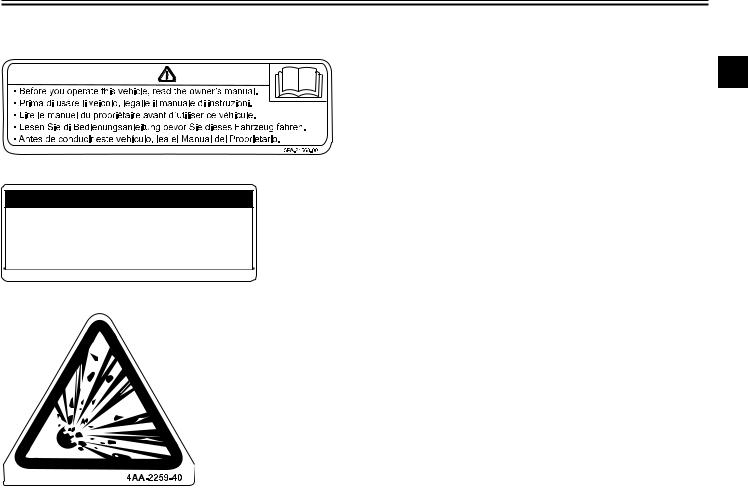
SAFETY INFORMATION
1
1
2
TIRE INFORMATION
Cold tire normal pressure should be set as follows.
FRONT: 100kPa, (1.00kgf/cm2), 15psi REAR: 100kPa, (1.00kgf/cm2), 15psi
3RV-21668-A0
3
1 - 7
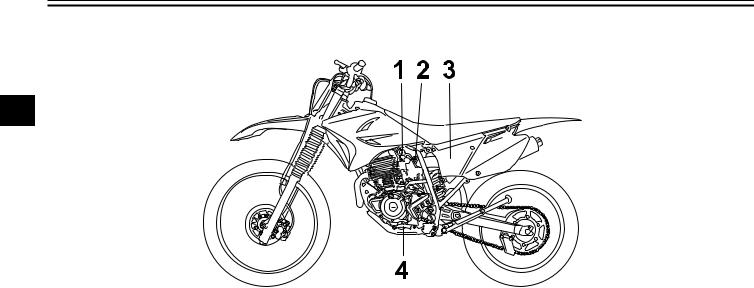
DESCRIPTION
Left view
2
1.Fuel cock (page 3-5)
2.Starter (choke) knob (page 3-6)
3.Air filter element (page 6-11)
4.Shift pedal (page 3-2)
2 - 1
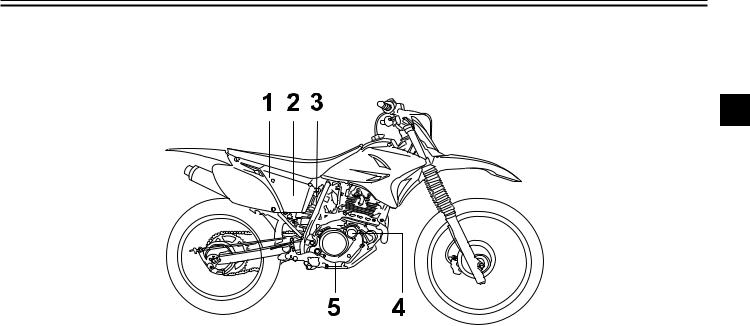
DESCRIPTION
Right view
2
1.Fuse (page 6-26)
2.Battery (page 6-24)
3.Shock absorver assembly spring preload adjusting nut (page 3-7)
4.Engine oil filter element (page 6-8)
5.Brake pedal (page 3-3)
2 - 2
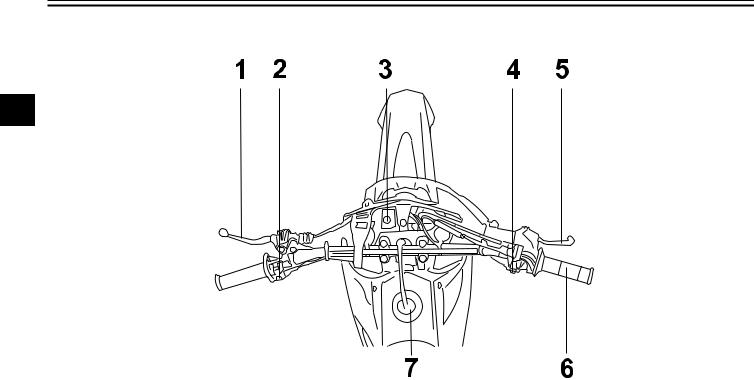
DESCRIPTION
Controls and instruments
2
1.Clutch lever (page 3-2)
2.Engine stop switch (page 3-1)
3.Main switch (page 3-1)
4.Start switch (page 3-1)
5.Brake lever (page 3-2)
6.Throttle grip (page 6-13)
7.Fuel tank cap (page 3-3)
2 - 3
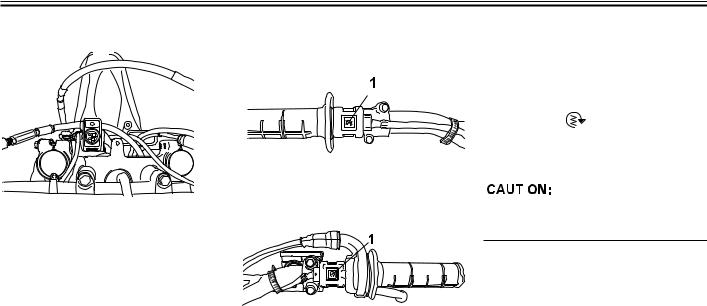
INSTRUMENT AND CONTROL FUNCTIONS
Main switch |
Handlebar switches |
|
Left |
1. Engine stop switch “ “
“
Engine stop switch “ ”
”
Push this switch to stop the engine in case of an emergency, such as when the motorcycle overturns or when the throttle cable is stuck.
Start switch “ |
” |
||||||
Push this switch to crank the engine with |
|
||||||
3 |
|||||||
the starter. |
|
|
|||||
|
|
|
|
|
|
|
|
|
|
|
|
|
|
|
|
|
|
|
|
|
|
|
|
|
|
|
|
|
|
|
|
The main switch controls the ignition systems. The various main switch positions are described below.
ON
All electrical systems are supplied with power, and the engine can be started.
OFF
All electrical systems are off.
Right
1. Start switch “ “
“
See page 5-1 for starting instructions prior to starting the engine.
3 - 1

INSTRUMENT AND CONTROL FUNCTIONS
Clutch lever |
Shift pedal |
Brake lever |
3
1. Clutch lever
The clutch lever is located at the left handlebar grip.To disengage the clutch, pull the lever toward the handlebar grip. To engage the clutch, release the lever. The lever should be pulled rapidly and released slowly for smooth clutch operation.
The clutch lever is equipped with a clutch switch, which is part of the starting circuit cut-off system. (See page 3-8.)
1. Shift pedal
The shift pedal is located on the left side of the engine and is used in combination with the clutch lever when shifting the gears of the 6-speed constant-mesh transmission equipped on this motorcycle.
1. Brake lever
The brake lever is located at the right handlebar grip.To apply the front brake, pull the lever toward the handlebar grip.
3 - 2
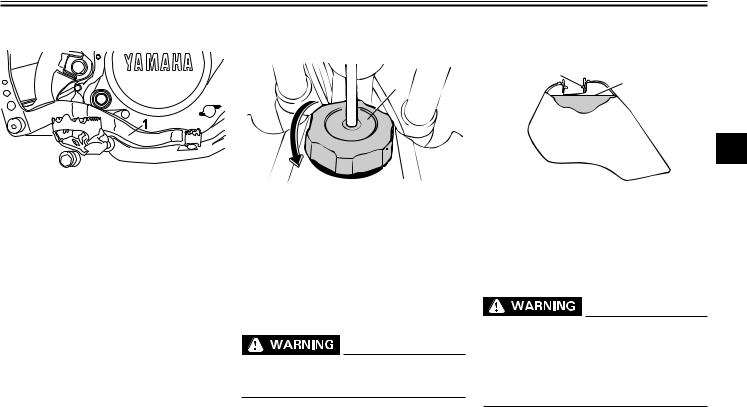
INSTRUMENT AND CONTROL FUNCTIONS
Brake pedal |
Fuel tank cap |
Fuel |
1. Brake pedal
The brake pedal is on the right side of the motorcycle.To apply the rear brake, press down on the brake pedal.
1 |
1 |
2 |
|
||
|
|
2 
1.Fuel tank cap
2.Remove
To remove the fuel tank cap, turn it counterclockwise, and then pull it off. To install the fuel tank cap, insert it into the tank opening, and then turn it clockwise.
Make sure that the fuel tank cap is properly closed before riding.
3
1.Fuel tank filter tube
2.Fuel lever
Make sure that there is sufficient fuel in the tank. Fill the fuel tank to the bottom of the filler tube as shown.
●Do not overfill the fuel tank, otherwise it may overflow when the fuel warms up and expands.
●Avoid spilling fuel on the hot engine.
3 - 3
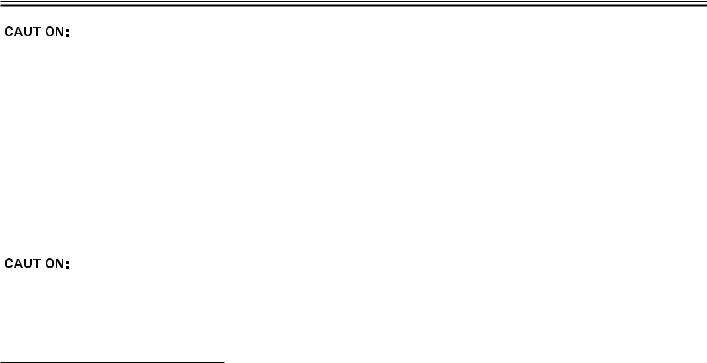
INSTRUMENT AND CONTROL FUNCTIONS
|
|
|
|
|
|
|
|
Immediately wipe off spilled fuel with |
|||
|
|
a clean, dry, soft cloth, since fuel may |
|||
|
|
deteriorate painted surfaces or plastic |
|||
|
|
parts. |
|||
|
|
|
|
|
|
|
|
|
|
|
|
3 |
|
Recommended fuel: |
|||
|
|
UNLEADED GASOLINE ONLY |
|||
|
|||||
|
|
Fuel tank capacity: |
|||
|
|
8.0 L (2.11 us.gal) (1.76 imp.gal) |
|||
|
|
Fuel reserve amount: |
|||
|
|
1.8 L (0.48 us.gal) (0.40 imp.gal) |
|||
|
|
|
|
|
|
|
|
|
|
|
|
|
|
|
|
|
|
|
|
|
|
|
|
Use only unleaded gasoline.The use of leaded gasoline will cause severe damage to internal engine parts, such as the valves and piston rings, as well as to the exhaust system.
YourYamaha engine has been designed to use regular unleaded gasoline with a pump octane number [(R+M)/2] of 86 or higher, or a research octane number of 91 or higher. If knocking (or pinging) occurs, use a gasoline of a different brand or premium unleaded fuel. Use of unleaded fuel will extend spark plug life and reduce maintenance costs.
Gasohol
●There are two types of gasohol: gasohol containing ethanol and that containing methanol. Gasohol containing ethanol can be used if the ethanol content does not exceed 10%. Gasohol containing methanol is not recommended by Yamaha because it can cause damage to the fuel system or vehicle performance problems.
3 - 4
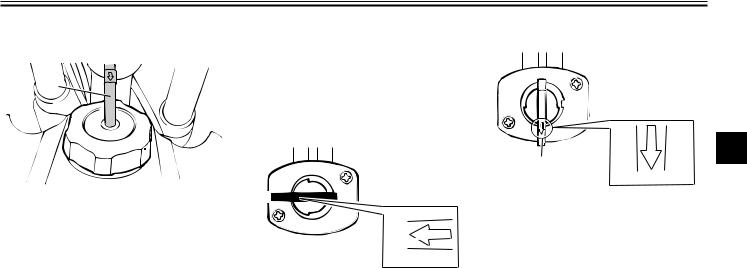
INSTRUMENT AND CONTROL FUNCTIONS
Fuel tank breather hose
1
1. Fuel tank breather hose
Before operating the motorcycle:
●Check the fuel tank breather hose connection.
●Check the fuel tank breather hose for cracks or damage, and replace it if damaged.
●Make sure that the end of the fuel tank breather hose is not blocked, and clean it if necessary.
Fuel cock
The fuel cock supplies fuel from the tank to the carburetor while filtering it also. The fuel cock has three positions:
OFF
RES
OFF 


FUEL
ON
1
1. Arrow mark positioned over “OFF”
With the lever in this position, fuel will not flow. Always return the lever to this position when the engine is not running.
ON
RES
OFF
FUEL
ON
3
ON 1
1. Arrow mark positioned over “ON”
With the lever in this position, fuel flows to the carburetor. Normal riding is done with the lever in this position.
3 - 5
